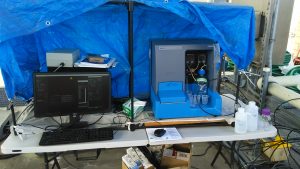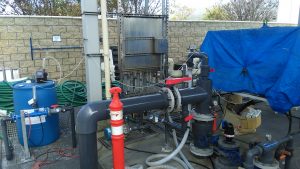The reclamation of wastewater to allow water reuse is critical to ensuring California’s water security in the face of droughts and increasing water demand.
 However, membrane filtration for the advanced treatment of wastewater, while allowing reuse, is energy intensive. This is largely due to the fouling of the membranes over time. Recent studies have shown that membrane fouling and the associated increase in energy demand is largely due to the deposition of colloidal particles (particles in nanoscale size) from the feed water inside of the membrane pores (pore plugging), which increases the transmembrane pressure (TMP).
However, membrane filtration for the advanced treatment of wastewater, while allowing reuse, is energy intensive. This is largely due to the fouling of the membranes over time. Recent studies have shown that membrane fouling and the associated increase in energy demand is largely due to the deposition of colloidal particles (particles in nanoscale size) from the feed water inside of the membrane pores (pore plugging), which increases the transmembrane pressure (TMP).
Currently, no techniques are available to measure colloidal particles directly in the feed water, which would facilitate appropriate pretreatment to remove these particles and minimize their deposition in membrane pores. Surrogate techniques such as measurement of turbidity or organic content are used by some utilities for monitoring “foulant” levels (i.e., compounds that “foul” the membranes). These techniques do not correlate well with levels of colloidal particles and, hence, lead to ineffective fouling control and inefficient energy use. Because of these limitations, many utilities do not pretreat the feed water prior to membrane treatment.
This project proposed field demonstration of a technology that directly measures the colloidal particle concentration and size distribution in the feed water, and hence, facilitate pretreatment for targeted removal of these particles. This technology (Nanoparticles Tracking Analysis [NTA] by Malvern Instruments) has been successfully commercialized for applications in other industries (medical, polymer).
 KJ led this technology transfer demonstration project. The proposed demonstration took place at Orange County Water District, Fountain Valley, CA and West Basin Municipal Water District, El Segundo, CA. The project used an on-line colloidal particle monitoring device developed by Malvern Instruments Ltd. This device detected and quantified colloidal particles in the membrane feed water and triggered appropriate pretreatment (coagulant) dosage to remove these particles. The pretreated water then treated submerged hollow fiber microfiltration (MF) membranes. The difference in TMP of untreated and pre-treated feed water during the membrane treatment process is used to estimate the energy savings due to implementation of the proposed technology. While effective colloidal particle removal can be achieved through the use of higher than optimal dosage, the excess coagulant can pass through the MF membrane and coat the reverse osmosis (RO) membrane often used in the downstream side of MF during water reclamation. This, in turn, can lower the capacity of the RO membrane and increase the energy demand. The ability of the proposed technology to administer the optimal dosage to remove colloidal particles effectively, while not allowing coating of RO membranes, was demonstrated using an RO pilot unit after the MF unit.
KJ led this technology transfer demonstration project. The proposed demonstration took place at Orange County Water District, Fountain Valley, CA and West Basin Municipal Water District, El Segundo, CA. The project used an on-line colloidal particle monitoring device developed by Malvern Instruments Ltd. This device detected and quantified colloidal particles in the membrane feed water and triggered appropriate pretreatment (coagulant) dosage to remove these particles. The pretreated water then treated submerged hollow fiber microfiltration (MF) membranes. The difference in TMP of untreated and pre-treated feed water during the membrane treatment process is used to estimate the energy savings due to implementation of the proposed technology. While effective colloidal particle removal can be achieved through the use of higher than optimal dosage, the excess coagulant can pass through the MF membrane and coat the reverse osmosis (RO) membrane often used in the downstream side of MF during water reclamation. This, in turn, can lower the capacity of the RO membrane and increase the energy demand. The ability of the proposed technology to administer the optimal dosage to remove colloidal particles effectively, while not allowing coating of RO membranes, was demonstrated using an RO pilot unit after the MF unit.
The pilot study data was used to estimate capital and O&M costs for the proposed technology, energy savings, and savings in membrane cleaning and replacement costs.
The specific goals of this project’s field demonstration included:
- Identifying optimal settings for the process control system for proper integration of the light scattering technology for colloidal particle monitoring with the pretreatment process.
- Demonstrating the ability of the instrument to measure colloidal particles and to determine the particle size range effectively as measured under dynamic flow conditions.
- Refine MF coagulant pre-treatment requirements and obtain performance data under field conditions
- Obtain reliable capital and operations and maintenance (O&M) cost data, including energy efficiency and resulting cost savings, to determine the return on investment (ROI) and to demonstrate economic viability of the proposed technology.

